

Removing field value highlighted in oracle forms in multi row block. How do i validate duplicate record in forms - Toolbox for IT Groups. Oracle Forms Monthly Archive for January 2011 - Toolbox for IT Groups. Avoid duplicated records in the same block. Oracle Forms Avoid duplicated records in a block Home page The purpose is to reject two records that contain duplicated values.

The technique used to solve this problem comes from the Kevin D Clarke’s calculated item famous solution. It uses two calculated items, one in the data bock and another in a control block. The first calculated item (:DEPT.MATCH_FOUND) is added to the DEPT block. Multiselect. It is composed of:
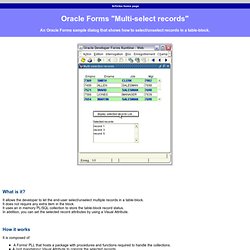
A Dynamic LOV. Oracle Forms Home page The purpose is to manage dynamic LOVs, able to build any LOV of 1 to 9 columns.
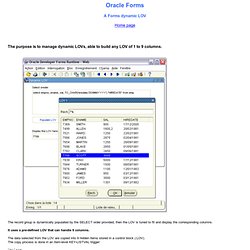
The record group is dynamically populated by the SELECT order provided, then the LOV is tuned to fit and display the corresponding columns. Entire Developer 2000. Oracle Forms. Designer -> Forms generation. Home page Because, when you generate Oracle Forms application from Oracle Designer, it is not always possible to place item at the exact position you want, this is a PL/SQL procedure which will do the job for you at runtime.
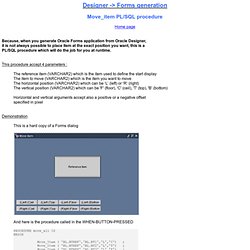
This procedure accept 4 parameters : The reference item (VARCHAR2) which is the item used to define the start display The item to move (VARCHAR2) which is the item you want to move. Jdevsamples - Sample applications for Oracle Fusion Middleware technology. Fdtool.free. Talk2Gerd. Oracle Forms6I Developers Guide. Color Mode. Oracle9i Developer Suite - A Tutorial on Oracle9i Forms and Reports. This tutorial introduces the Oracle 9i, Oracle 10g and Oracle 11g Developer Suite Release 2 that includes Oracle Forms and Oracle Reports.
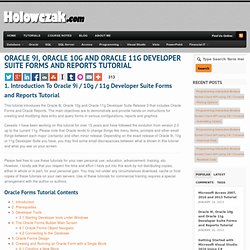
The main objectives are to demonstrate and provide hands-on instructions for creating and modifying data entry and query forms in various configurations, reports and graphics. Caveats: I have been working on this tutorial for over 15 years and have followed the evolution from version 2.0 up to the current 11g. Please note that Oracle tends to change things like menu items, prompts and other small things between each major (certainly) and often minor release. Depending on the exact release of Oracle 9i, 10g or 11g Developer Suite you have, you may find some small discrepancies between what is shown in this tutorial and what you see on your screen. Please feel free to use these tutorials for your own personal use, education, advancement, training, etc. FORMS CUSTOMIZATION. 1.

Open APPSTAND form in your current form first 2. drag and drop QUERY_FIND object from APPSTAND as COPY onto c01_CHN_REP form. After It copies in three places. 1. then Delete QUERY_FIND object group from your C01_CHN_REP form. Query Find There are two implementations for Query Find. One implementation shows a Row–LOV that shows the available rows and allows you to choose one. The other implementation opens a Find window, which shows you the fields the user is likely to want to use for selecting data. Step 1: Copy the Query_find object group from APPSTAND, by opening APPSTAND form. Step 2: Rename the New Block, Canvas and Window just now created please !! For this example, rename the block, canvas and window to QF_BLK, QF_CANVAS and QF_W Step3: Edit the NEW Button’s Triggerin the QF_BLK provided button. Oracle Functions - Sum, Average, Max, Min...
Steve Rea's Oracle and SunGardHE Banner Tips, Tricks, and Scripts. Oracle Unleashed. As stated in the previous chapter, Oracle Forms 4.5 is a development tool that can be used to create applications to enter, access, change, or delete data from an Oracle database in an online, form-based environment.
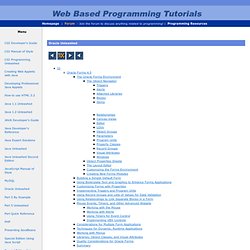
Forms has provided many objects for developing an effective application module. Coupled with the concept of user extensibility, Forms can be used to serve virtually every online need in an Oracle database environment. This chapter will explore many of the concepts related to Oracle Forms development. The examples will start with a few baby steps and gradually add enough information so that you will be able to walk on your own. With each advance in complexity, the applications will become more powerful. FormsMagnifier. Click to see the full size image Click to see the full size image Try it !
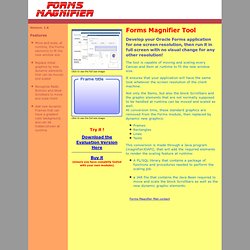
Download the Evaluation VersionHere Buy it(ensure you have completly tested with your own modules) Search. Start - Oracle Sample Code : Welcome. Welcome to the Oracle Sample Code public repository, where Oracle Technology Network members collaboratively build and share sample applications, code snippets, skins and templates, and more. What can I do with the sample code hosted here? Download the sample code here to learn or help accelerate your own development efforts. Or, team up with others to create your own sample code using the workspaces and tools provided here. Start - move records in oracle forms 6. Craig's Oracle Stuff. I decided to create this site as a way of sharing some of the knowledge and experience I've learned over the years while developing Oracle Forms applications using the Oracle Developers Suite.

I started working with Oracle products in 1997. It wasn't "Love at First Site" but eventually we grew on each other. I'm still working with Oracle products today. I have worked extensively with the Oracle Database, primarily schema design, Stored Procedure development and Oracle Forms/Reports development. Forms: How to - Create a Multiline Text Counter - Craig's Oracle Stuff.
What is a multiline text counter you ask?
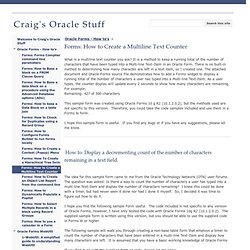
It is a method to keep a running total of the number of characters that have been typed into a Multi-line Text-Item in an Oracle Form. There is no built-in method to determining how many character are left in a text item, so I created one. The attached document and Oracle Forms source file demonstrates how to add a Forms widget to display a running total of the number of characters a user has typed into a Multi-line Text-Item. As a user types, the counter display will update every 2 seconds to show how many characters are remaining. MLline_Text_Counter-screen-shot.png (PNG Image, 557×442 pixels)
Forms How To: Create a Hierachical Tree form - Craig's Oracle Stuff. Oracle Forms Hierarchical Tree widget is one of the more complex widgets available in Oracle Forms. The key to using this widget is to understand how to populate it with data. A Hierarchical Tree (HT) can be thought of as a Master and Detail or Parent and Child(ren) relationship. An HT is made up of a root node, parent node and children node(s). Children nodes can be parents themselves. Think of it from the analogy of a Parent, Child and Grandchild. This “How To” document will use the sample HR.DEPARTMENTS and HR.EMPLOYEES tables as the source tables for the tree.
Avoid duplicated records in the same block. Oracle Forms Avoid duplicated records in a block Home page The purpose is to reject two records that contain duplicated values. The technique used to solve this problem comes from the Kevin D Clarke’s calculated item famous solution. It uses two calculated items, one in the data bock and another in a control block. The first calculated item (:DEPT.MATCH_FOUND) is added to the DEPT block. Comparaison(:ctrl.charsave, :dept.deptno||:dept.dname) Notice in this case,that we want to avoid duplicates on both DEPTNO and DNAME values. Function COMPARAISON (val1 varchar2, val2 varchar2) Forms - Record Group Processing (Duplicate Value Checking) - Craig's Oracle Stuff. Almost everyone who works with Oracle Forms knows what a Record Group (RG) is and how to use them to supply the data set to a Forms List Of Values (LOV) or Poplist/TList objects. What many people don't know is that there are a set of Forms Built-Ins for dynamically creating a Record Group in memory which gives you the ability to perform Array type processing using native Forms funcationality versus using a PL/SQL Collection, VArray, etc.
I have used RGs to keep track of rows selected in a multi-record block, perform duplicate checking, as well as many other tasks. In this demo, I give an example of how to perform Duplicate value checks and search a multi-record block for a specific value. Typically, the search for a value in a multi-record block is done by navigating to the target block and the first record of the block and then looping through each row of the block until the specified value is found. Rec_group.v2.zip - Powered by Google Docs. Forms How to: Dynamically Populate a Poplist - Craig's Oracle Stuff.